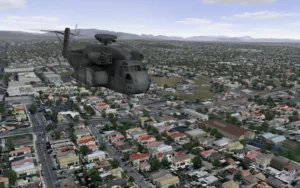At I/ITSEC 2015, Rockwell Collins announced a new project called the WholeEarth Synthetic Database, which, as you might suspect, is a database of the entire Earth. They are not the first ones to attempt to do this, but they are doing it in a way that has a manageable file size and cost, while offering a platform that can accommodate higher fidelity additions.
In the world of commercial and military flight simulation, databases are built up of the terrain in a very complex manner. High fidelity is needed for close-to-earth flying while less fidelity is needed at higher altitudes. But databases are usually one or the other, with high fidelity custom databases costing millions of dollars to develop.
Commercial aircraft are really only interested in high fidelity for take offs and landings, while helicopters generally need a pretty high fidelity database for all their missions.
What Rockwell Collins has done is to start by using commercially available Landsat 30 meter resolution data as a low fidelity starting point. They then add “geo-typical swatches” to increase the resolution to about ½ meter. Geo-typical swatches means that they look at the terrain; dessert, forest, city, etc, and they generate generic detailed images with higher fidelity that overlays the low fidelity 30 meter data. It is not fully accurate, but representative of the terrain over which you are flying.
But even generating generic geo-typical swatches is a big task as forests, deserts and farmland all look different in different parts of the world. As a result, the company will focus on the US for the first release in May 2016, then add other regions in 6-month release cycles, to hopefully complete the process in two years.
The database is more than an out-the-window type of database. That means you can change the time of day with the click of a button, add fog or smoke and even change the season of the year or add IR wavebands for night vision applications. That’s pretty sophisticated and all available in a 2TB package.
But this database still will not meet the needs of many users. That’s where the money-saving part comes in. Instead of building high fidelity databases from scratch, users can start with the foundation that Rockwell Collins provides and layer higher fidelity on top, including all kinds of custom models and insets developed at dozens of companies – including Rockwell Collins.
The WholeEarth database is only available if you purchase the new EP 9100 Image Generator hardware, but you can buy the hardware without the database. And the extra cost of the WholeEarth database will quite reasonable, says the company.
(Check the video for more Rockwell Collins Announces WholeEarth Database at IITSEC 2015.)

